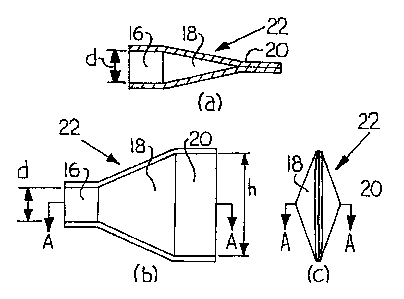Some of the information on this Web page has been provided by external sources. The Government of Canada is not responsible for the accuracy, reliability or currency of the information supplied by external sources. Users wishing to rely upon this information should consult directly with the source of the information. Content provided by external sources is not subject to official languages, privacy and accessibility requirements.
Any discrepancies in the text and image of the Claims and Abstract are due to differing posting times. Text of the Claims and Abstract are posted:
| (12) Patent: | (11) CA 2366605 |
|---|---|
| (54) English Title: | CHECK VALVE WITH OVERSIZED BILL |
| (54) French Title: | CLAPET DE NON-RETOUR A BEC SURDIMENSIONNE |
| Status: | Term Expired - Post Grant Beyond Limit |
| (51) International Patent Classification (IPC): |
|
|---|---|
| (72) Inventors : |
|
| (73) Owners : |
|
| (71) Applicants : |
|
| (74) Agent: | WILSON LUE LLP |
| (74) Associate agent: | |
| (45) Issued: | 2004-10-12 |
| (22) Filed Date: | 2002-01-04 |
| (41) Open to Public Inspection: | 2003-07-04 |
| Examination requested: | 2002-04-30 |
| Availability of licence: | N/A |
| Dedicated to the Public: | N/A |
| (25) Language of filing: | English |
| Patent Cooperation Treaty (PCT): | No |
|---|
| (30) Application Priority Data: | None |
|---|
A check valve having an upstream inlet part mountable on a discharge end of a conduit, a downstream outlet part adapted to prevent backflow of fluid through the check valve, and a transition part located between the upstream inlet part and the downstream outlet part. A longitudinal dimension of the downstream outlet part extending in a direction transverse to a direction of flow is at least approximately 1.57 times the diameter of the upstream inlet part.
Un clapet de non-retour présentant une partie d'admission en amont montable sur une extrémité de décharge d'un conduit, une partie de sortie en aval conçu pour empêcher le reflux de liquide par le clapet de non-retour, et une partie de transition située entre la partie d'admission en amont et la partie de sortie en aval. Une dimension longitudinale de la partie de sortie en aval s'étendant dans une direction transversale à une direction du flux fait au moins environ 1,57 fois le diamètre de la partie d'admission en amont.
Note: Claims are shown in the official language in which they were submitted.
Note: Descriptions are shown in the official language in which they were submitted.

2024-08-01:As part of the Next Generation Patents (NGP) transition, the Canadian Patents Database (CPD) now contains a more detailed Event History, which replicates the Event Log of our new back-office solution.
Please note that "Inactive:" events refers to events no longer in use in our new back-office solution.
For a clearer understanding of the status of the application/patent presented on this page, the site Disclaimer , as well as the definitions for Patent , Event History , Maintenance Fee and Payment History should be consulted.
| Description | Date |
|---|---|
| Inactive: Expired (new Act pat) | 2022-01-04 |
| Maintenance Fee Payment Determined Compliant | 2020-01-15 |
| Inactive: Late MF processed | 2020-01-15 |
| Common Representative Appointed | 2019-10-30 |
| Common Representative Appointed | 2019-10-30 |
| Inactive: Late MF processed | 2019-01-09 |
| Letter Sent | 2019-01-04 |
| Inactive: Agents merged | 2018-02-19 |
| Inactive: Office letter | 2018-02-19 |
| Revocation of Agent Request | 2017-12-29 |
| Appointment of Agent Request | 2017-12-29 |
| Inactive: Office letter | 2016-11-28 |
| Inactive: Adhoc Request Documented | 2016-11-28 |
| Appointment of Agent Request | 2016-11-03 |
| Revocation of Agent Request | 2016-11-03 |
| Inactive: Payment - Insufficient fee | 2011-12-29 |
| Inactive: IPC from MCD | 2006-03-12 |
| Grant by Issuance | 2004-10-12 |
| Inactive: Cover page published | 2004-10-11 |
| Inactive: Final fee received | 2004-07-27 |
| Pre-grant | 2004-07-27 |
| Letter Sent | 2004-05-18 |
| Notice of Allowance is Issued | 2004-05-18 |
| 4 | 2004-05-18 |
| Notice of Allowance is Issued | 2004-05-18 |
| Inactive: Approved for allowance (AFA) | 2004-04-19 |
| Application Published (Open to Public Inspection) | 2003-07-04 |
| Inactive: Cover page published | 2003-07-03 |
| Amendment Received - Voluntary Amendment | 2002-07-18 |
| Letter Sent | 2002-06-17 |
| Request for Examination Received | 2002-04-30 |
| Request for Examination Requirements Determined Compliant | 2002-04-30 |
| All Requirements for Examination Determined Compliant | 2002-04-30 |
| Inactive: First IPC assigned | 2002-02-19 |
| Inactive: Filing certificate - No RFE (English) | 2002-02-04 |
| Letter Sent | 2002-02-04 |
| Application Received - Regular National | 2002-02-04 |
There is no abandonment history.
The last payment was received on 2004-01-05
Note : If the full payment has not been received on or before the date indicated, a further fee may be required which may be one of the following
Patent fees are adjusted on the 1st of January every year. The amounts above are the current amounts if received by December 31 of the current year.
Please refer to the CIPO
Patent Fees
web page to see all current fee amounts.
Note: Records showing the ownership history in alphabetical order.
| Current Owners on Record |
|---|
| RED VALVE CO., INC. |
| Past Owners on Record |
|---|
| ANDRE T. ABROMAITIS |
| MICHAEL J. DUER |
| SPIROS G. RAFTIS |